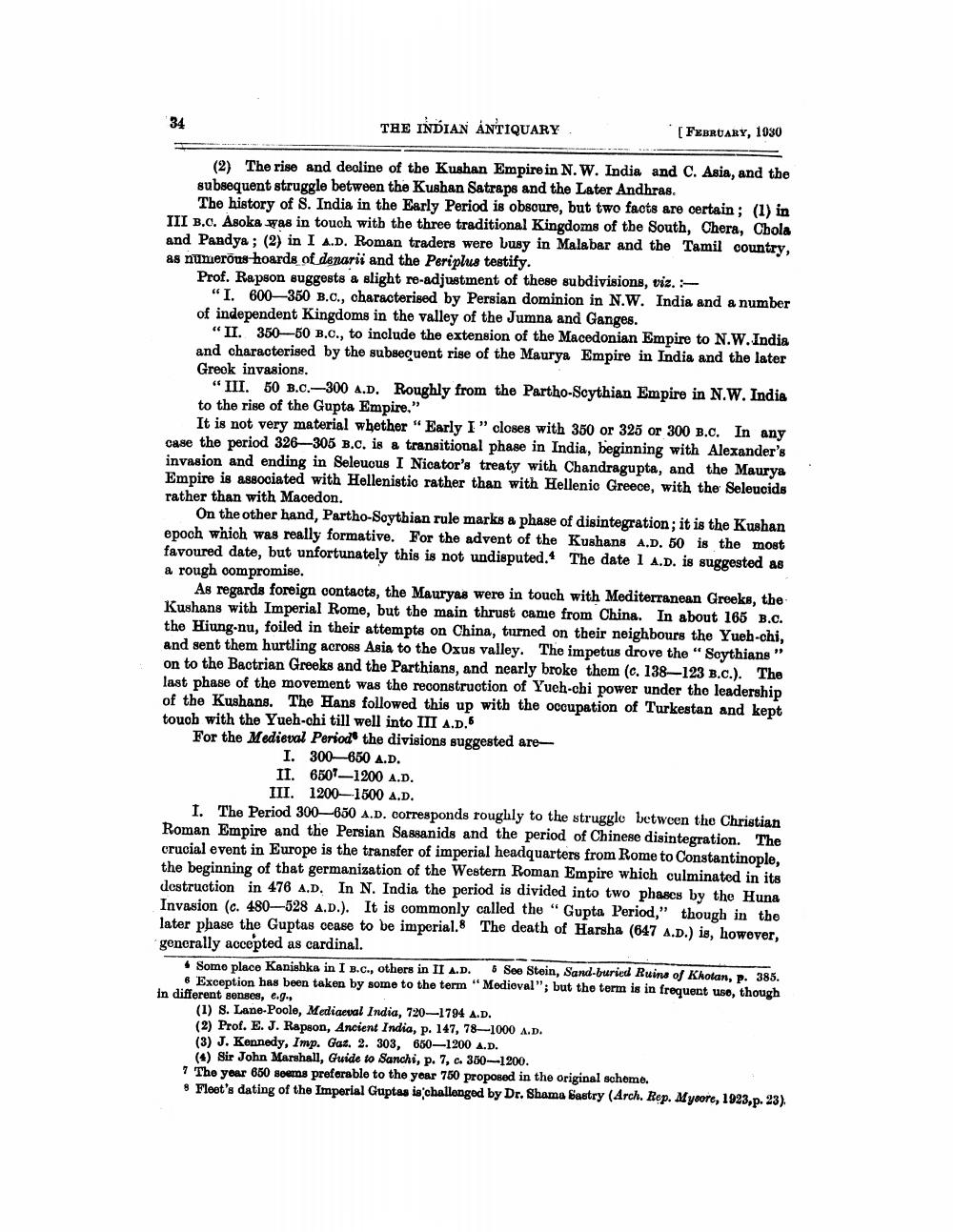________________
THE INDIAN ANTIQUARY
[ FEBRUARY, 1930
(2) The rise and dealine of the Kushan Empire in N. W. India and C. Asia, and the subsequent struggle between the Kushan Satraps and the Later Andhras.
The history of S. India in the Early Period is obscure, but two facts are certain ; (1) in III B.C. Asoka was in touch with the three traditional Kingdoms of the South, Chera, Chola and Pandya; (2) in I A.D. Roman traders were busy in Malabar and the Tamil country, as numerous hoards of denarii and the Periplus testify.
Prof. Rapson suggests a slight re-adjustment of these subdivisions, viz.
"I. 600-350 B.C., characterised by Persian dominion in N.W. India and a number of independent Kingdoms in the valley of the Jumna and Ganges.
"II. 350—50 B.C., to include the extension of the Macedonian Empire to N.W.India and characterised by the subsequent rise of the Maurya Empire in India and the later Greek invasions.
“III. 50 B.C.-300 A.D. Roughly from the Partho-Scythian Empire in N.W. Indis to the rise of the Gupta Empire."
It is not very material whether "Early I"closes with 350 or 325 or 300 B.C. In any case the period 326-305 B.c. is a transitional phase in India, beginning with Alexander's invasion and ending in Seleuous I Nicator's treaty with Chandragupta, and the Maurya Empire is associated with Hellenistio rather than with Hellenic Greece, with the Seleucids rather than with Macedon.
On the other hand, Partho-Soythian rule marks a phase of disintegration; it is the Kushan epoch which was really formative. For the advent of the Kushans A.D. 50 is the most favoured date, but unfortunately this is not undisputed.4 The date 1 A.D. is suggested as a rough compromise.
As regards foreign contacts, the Mauryas were in touch with Mediterranean Greeks, the Kushans with Imperial Rome, but the main thrust came from China. In about 165 B.C. the Hiung-nu, foiled in their attempts on China, turned on their neighbours the Yueb-chi, and sent them hurtling across Asia to the Oxus valley. The impetus drove the "Scythians" on to the Bactrian Greeks and the Parthians, and nearly broke them (c. 138-123 B.C.). The last phase of the movement was the reconstruction of Yueh-chi power under the leadership of the Kushans. The Hans followed this up with the occupation of Turkestan and kept touch with the Yueh-chi till well into III A.D.6 For the Medieval Period the divisions suggested are
I. 300—650 A.D. II. 6501-1200 A.D.
III. 1200—1500 A.D. 1. The Period 300-650 A.D. corresponds roughly to the strugglo between the Christian Roman Empire and the Persian Sassanids and the period of Chinese disintegration. The crucial event in Europe is the transfer of imperial headquarters from Rome to Constantinople, the beginning of that germanization of the Western Roman Empire which culminated in its destruction in 476 A.D. In N. India the period is divided into two phases by the Huna Invasion (c. 480-528 A.D.). It is commonly called the "Gupta Period,” though in the later phase the Guptas ocase to be imperial. The death of Harsha (647 A.D.) is, however, generally accepted as cardinal.
* Somo placo Kanishka in I B.C., others in II A.D. 6 See Stein, Sand-buried Ruins of Khotan, p. 385.
6 Exception has been taken by some to the term "Modioval"; but the term is in frequent use, though in different senses, e.g.
(1) S. Lane-Poole, Mediaeval India, 720-1794 A.D. (2) Prof. E. J. Rapson, Ancient India, p. 147, 78—1000 A.D. (3) J. Kennedy, Imp. Gaz. 2. 303, 650–1200 A.D.
(4) Sir John Marshall, Guide to Sanchi, p. 7, c. 350-1200. 7 The year 650 seerns preferable to the year 750 proposed in the original scheme. 8 Fleet's dating of the Imperial Guptas is challenged by Dr. Shama bastry (Arch. Rep. Mysore, 1923,p. 23)




